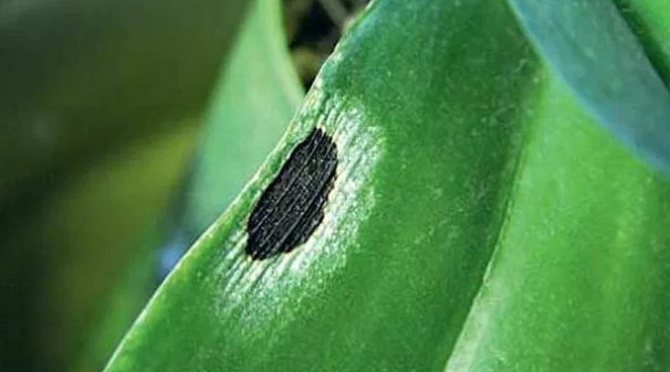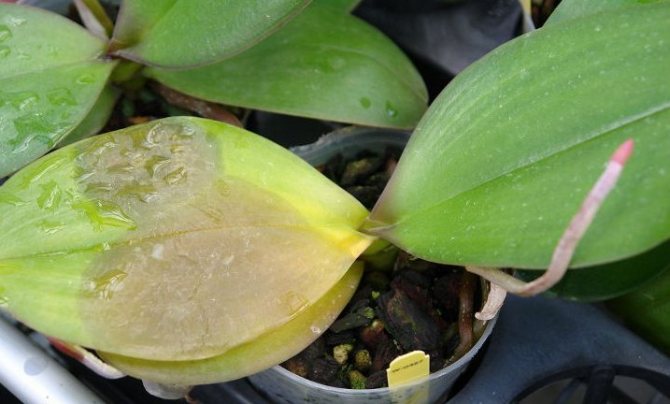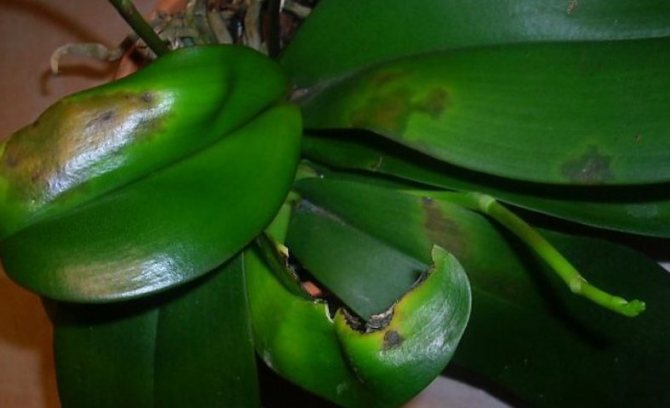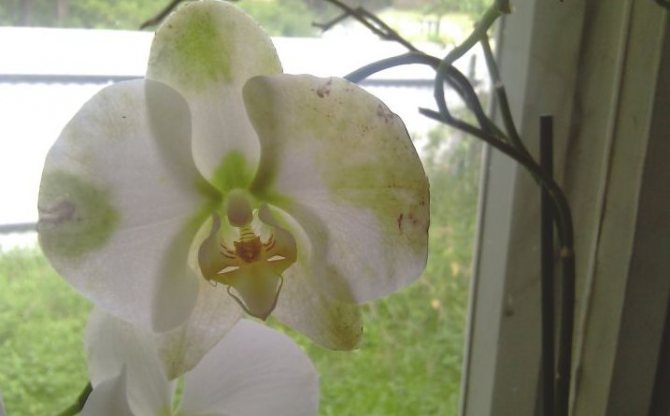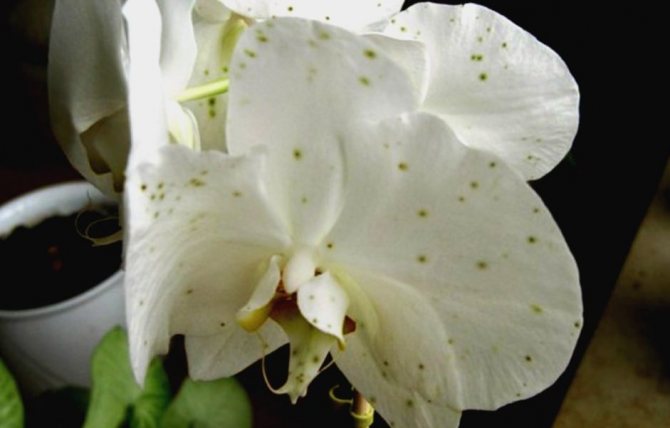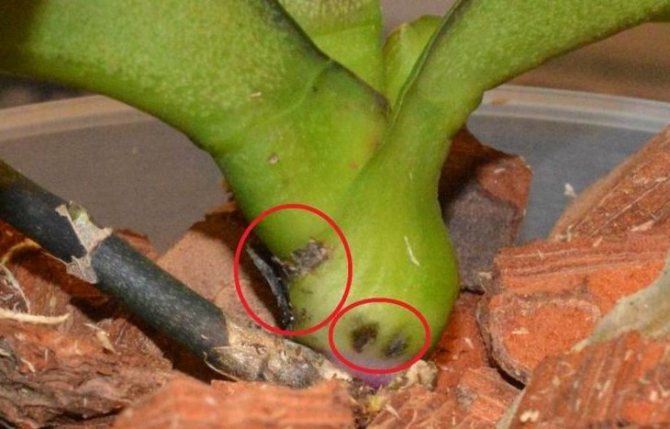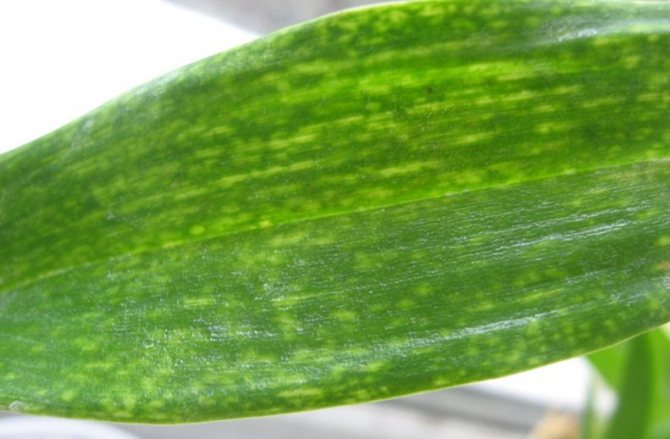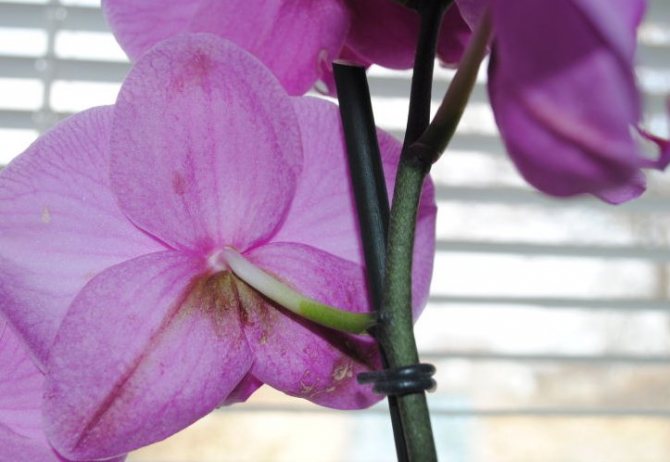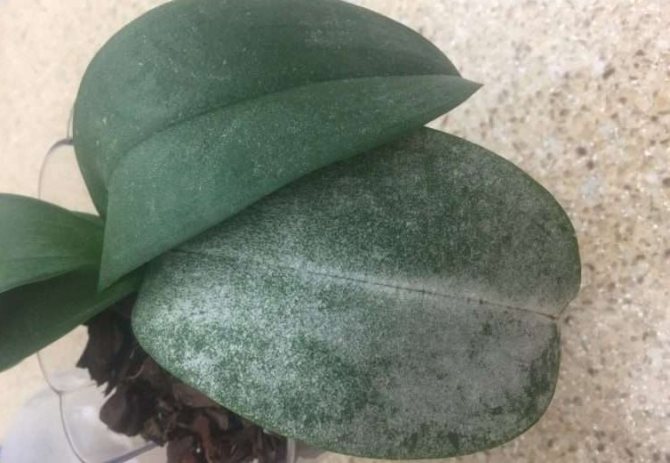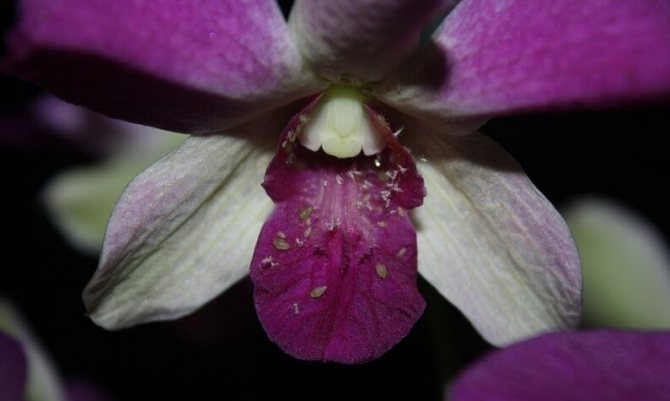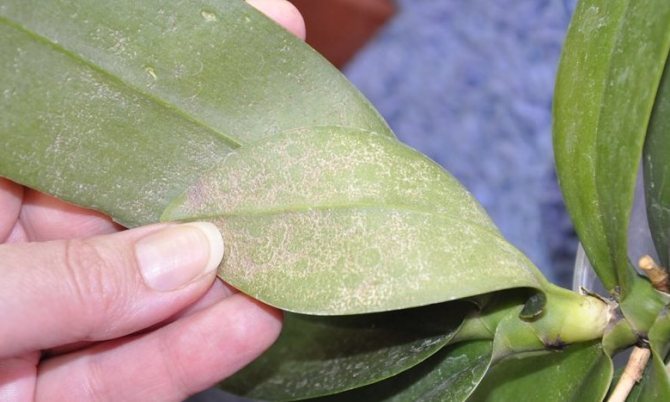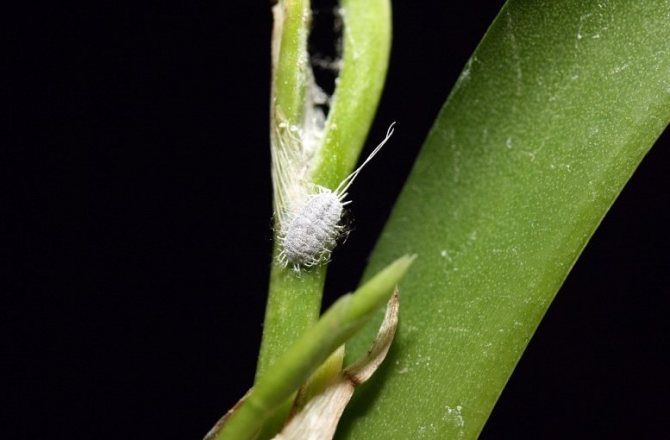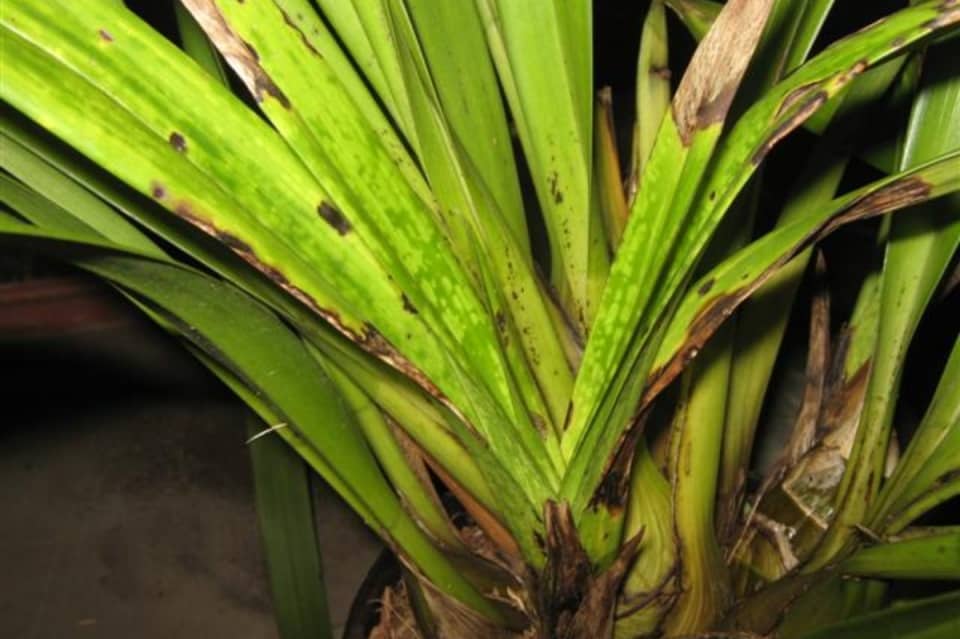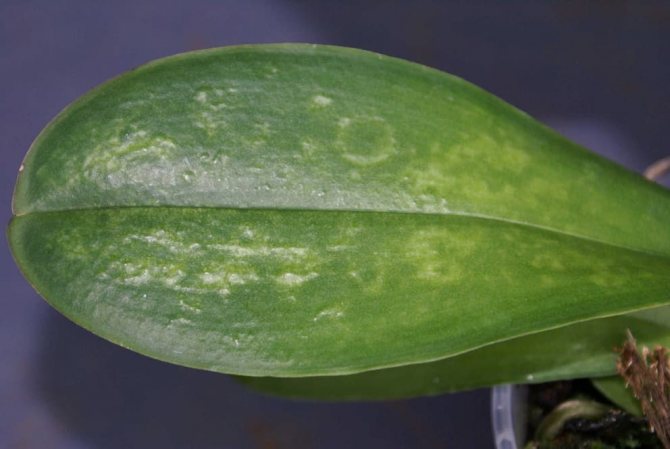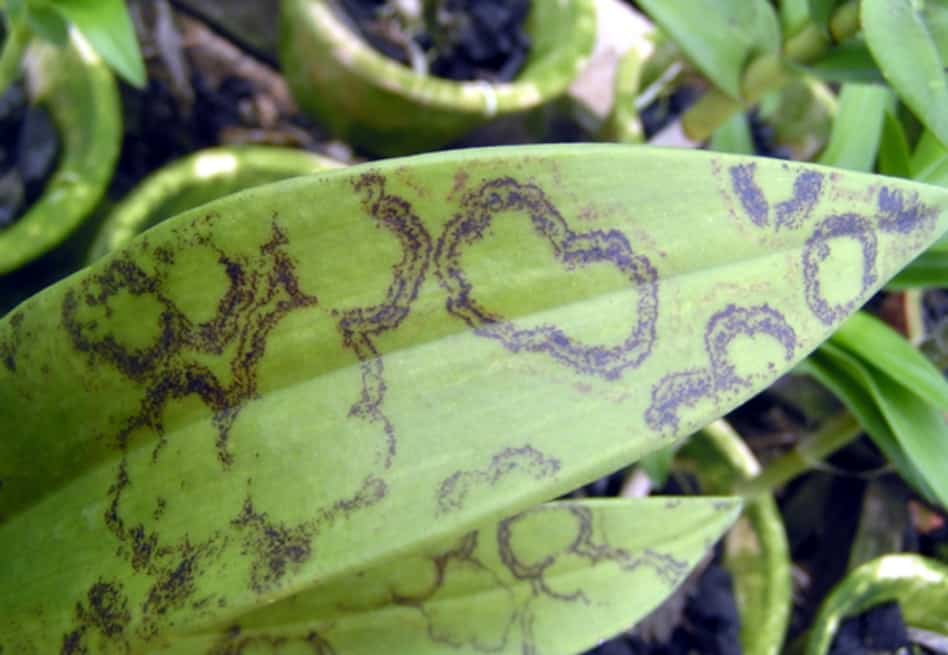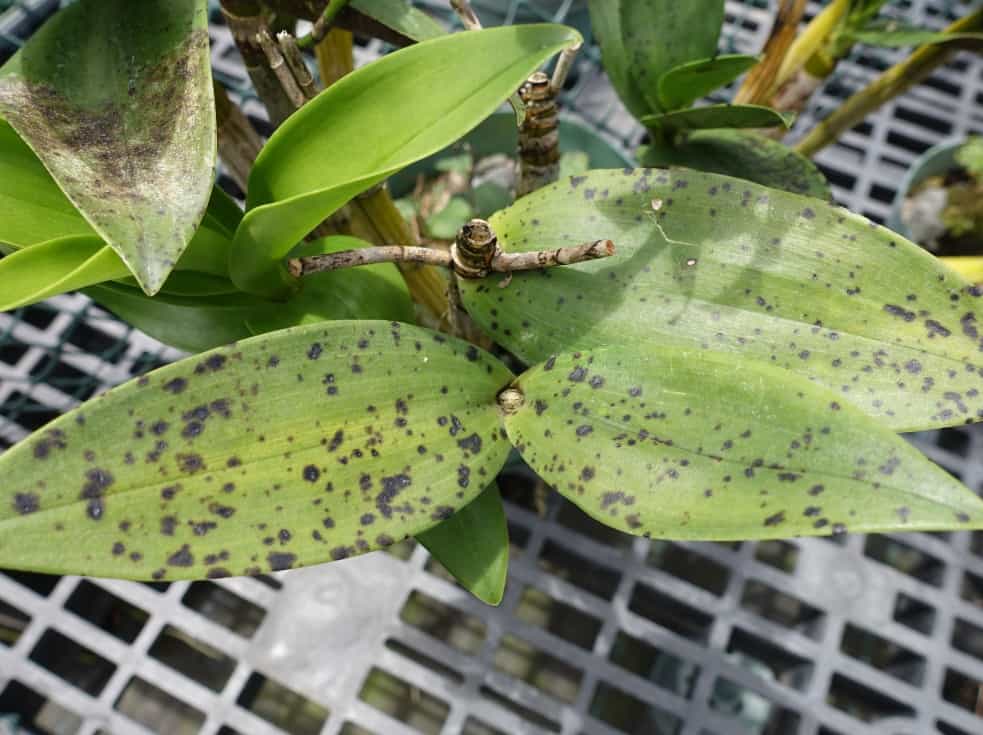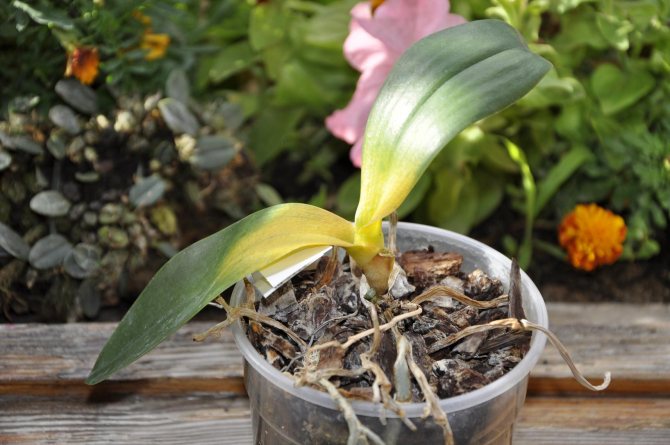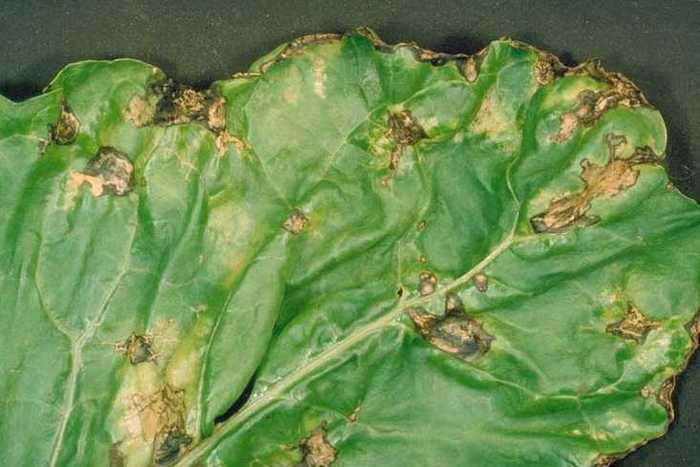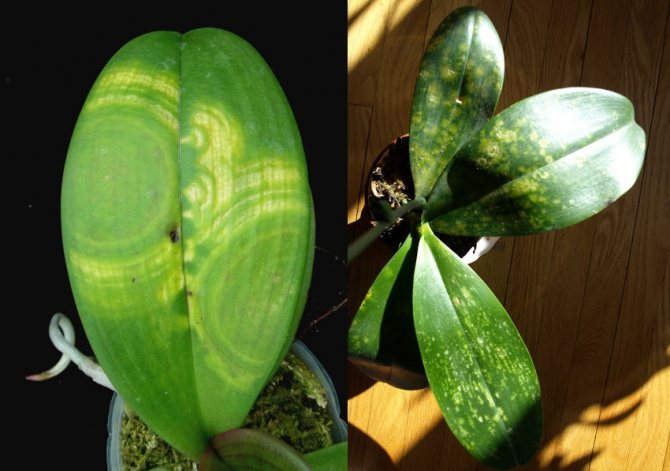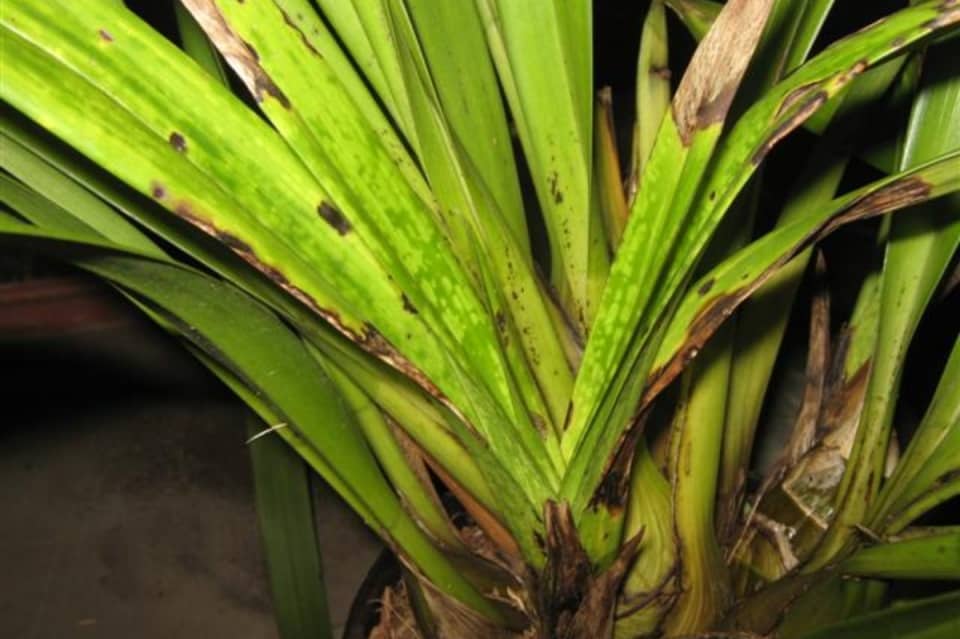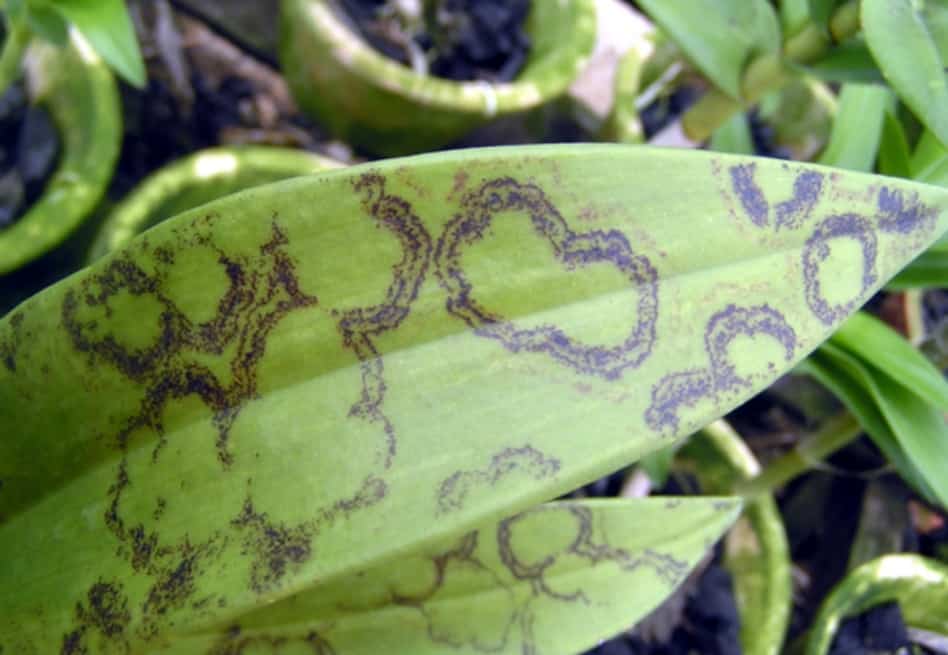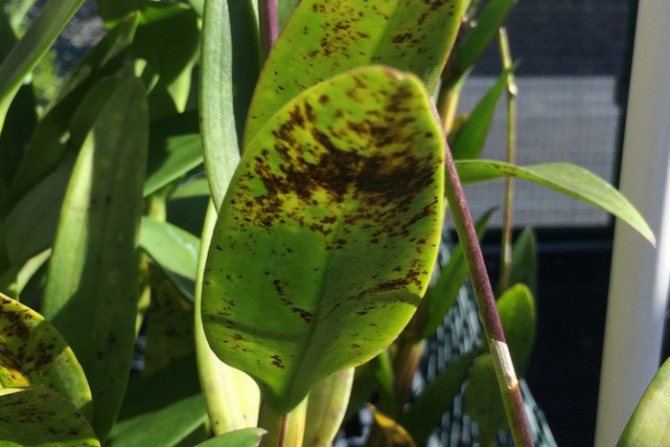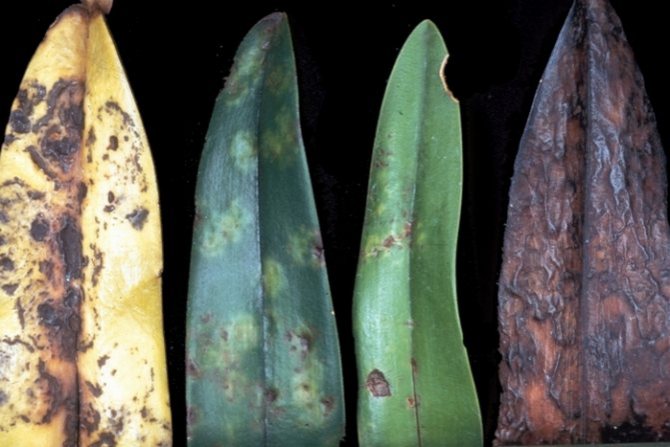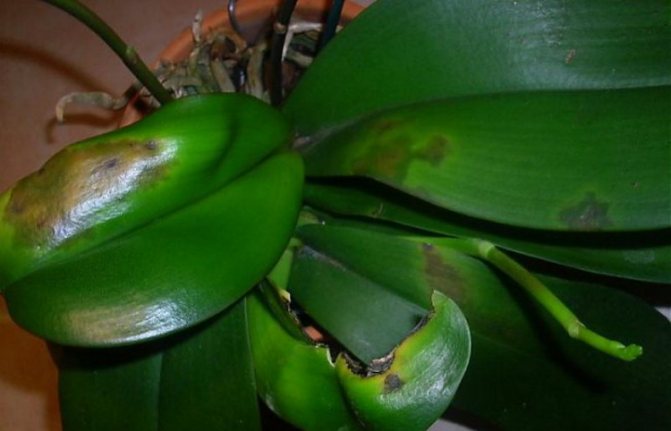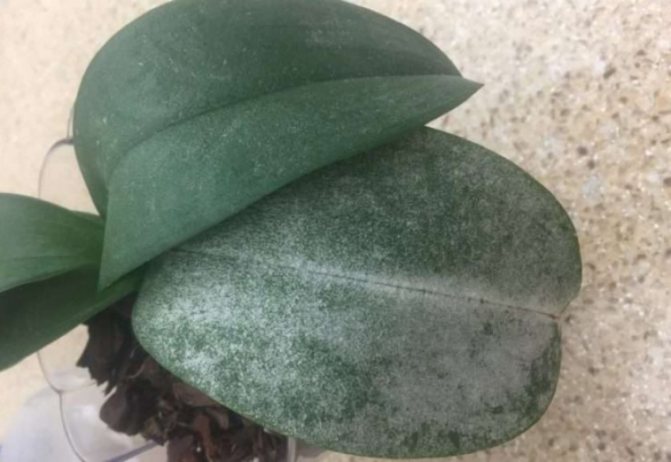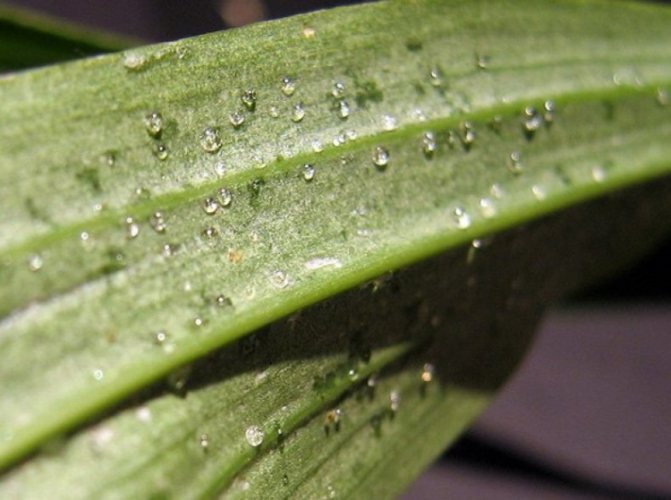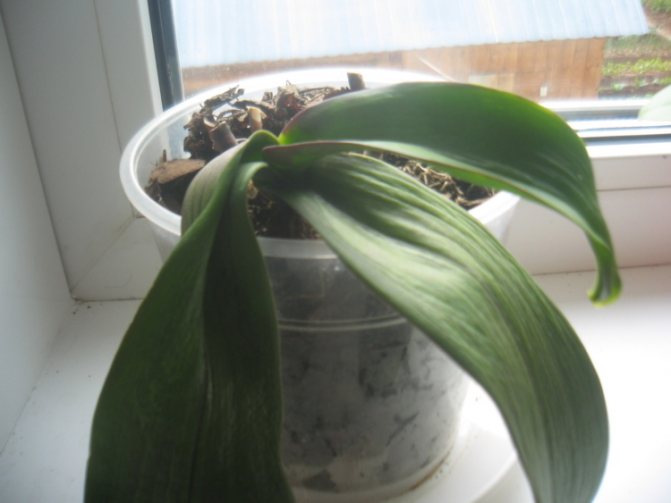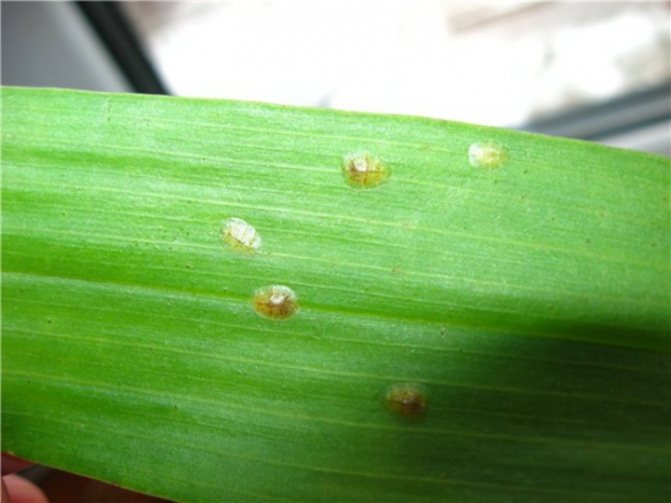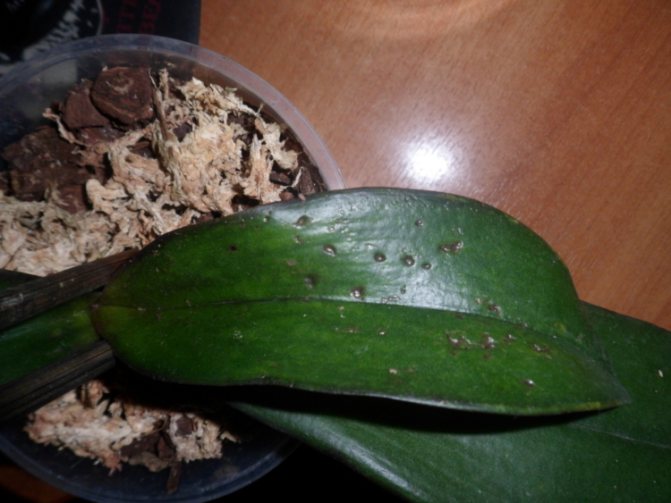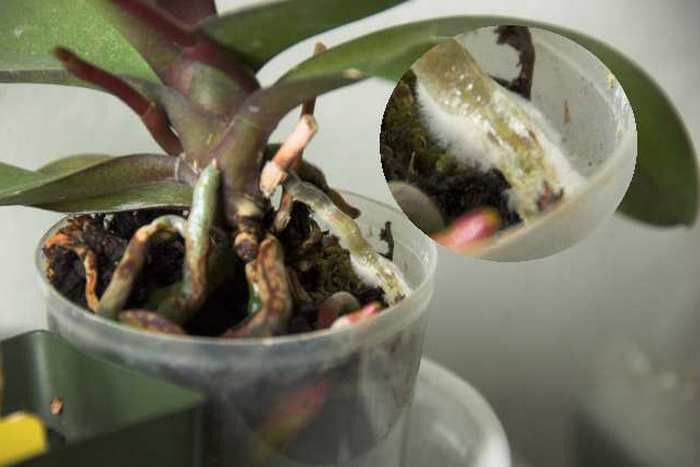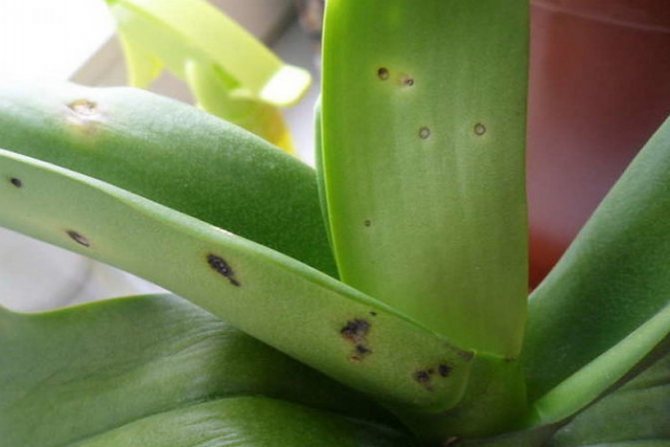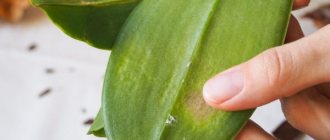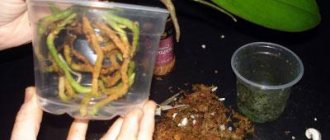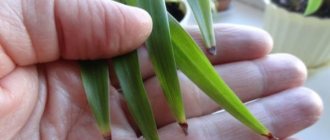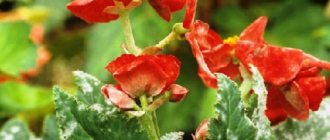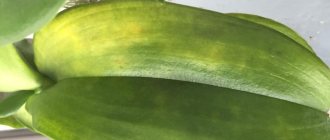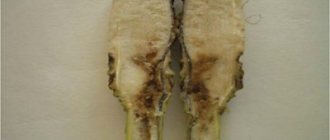
For many owners of home collections of exotic plants, viral diseases of orchids sound like a sentence for a flower: treatment is impossible, there is only one way out - only to dispose of it. Is this really so, maybe there is at least a small chance to save exotic beauties?
More than 50 viruses found on the plants of the family are known to modern specialists in Orchid breeding. Some of them affect many types of orchids, others only flowers of a certain kind. They manifest themselves in different ways, even the same virus on the leaves of different plants, which differ in the texture of the leaf plates, looks different.
Classification of phalaenopsis leaf diseases: infectious and non-infectious
Noticing unpleasant symptoms on the leaves, first of all, you need to find out the nature of the disease. It can be infectious or non-infectious:
- Non-communicable diseases are always associated with a violation of agricultural technology. These can be improper watering, overheating or frostbite, sunburn or phytolamps.
- Infectious diseases develop when any pathogen - a fungus, bacteria or virus - enters the leaf tissue.
According to statistics, phalaenopsis often suffer from the first group of diseases - non-infectious ones. Outbreaks of infections occur mainly in large collections, where plants rotate constantly, and the conditions of detention are rather crowded.
Is it possible to treat orchid viral disease
Most experts say that it is advisable to destroy plants infected with the virus immediately so that the infection does not spread to other flowers. However, there are cases when a leaf with signs of a viral infection that appeared on its surface was immediately cut off from the flower, diagnosed positively and destroyed, and the plant developed normally for another 5–7 years without the manifestation of the disease.
Each florist has the right to decide independently what to do with his orchids, but today it is believed that there is no effective way to cure exotic plants from being infected with a viral infection.


Viruses
The defeat of domestic orchids with a real virus is something out of the ordinary. Because in the industrial cultivation of plants, this issue is very tough. All infected specimens are destroyed.
Symptoms Chlorotic and necrotic spots, stripes, lines or rings on leaves, less often flowers, slow growth, poor, irregular flowering.


Taiwan Orchid Virus
It is very difficult to accurately diagnose a virus based on visual symptoms alone, as it can disguise itself as other diseases. The causative agent can only be identified in laboratory conditions.
Most often, the symptoms with a suspected virus are actually symptoms of a banal waterlogging.
But just in case, remember that viruses are incurable, but plants do not die from them. With the normalization of the conditions of detention, the symptoms disappear and an orchid with a strong immune system can continue to live with this virus for a long time.
General preventive measures
- Buy healthy plants. Inspect the leaves for reddish brown or black spots before purchasing.Don't buy plants with spotted leaves.
- Provide air circulation. Orchids love moisture, but bacteria love it too.
- Avoid overflow. Besides killing the roots of your orchid, standing water is like inviting unwanted bacteria to settle in your orchids. Learn how to water properly and you will avoid the root causes of orchid death.
- Insulation. As an extra precaution, isolate the new plant for a week or two to make sure it doesn't bring in new viruses. Sometimes we can overlook bacterial stains that somehow become glaringly obvious once at home. If you notice something unusual, the first step is to identify the problem so you can apply the correct treatment.
- If your orchid has a leaf that looks bad, cut it off. Pruning the affected area with a pair of sterilized scissors is another option. To sterilize the scissors, wipe them with a cotton swab dipped in alcohol. When making a cut, trim about 1 cm past the black spot. If the entire leaf is affected, cut off the entire leaf at the base.
Noticing in time that the leaves are covered with spots, have lost their elasticity or have changed color, you can quickly help your orchid and avoid the sad consequences. With proper care, orchid leaves will delight the eye with their greenery. A flower will live a long life, filling your home with comfort and beauty.
Non-infectious leaf diseases associated with improper watering
The most common cause of problems with phalaenopsis leaves is over or just inappropriate irrigation. Phalaenopsis are classic epiphytes, that is, plants whose roots are adapted to the air environment. They need high humidity, but constant presence in damp soil is categorically contraindicated. The bay leads to the death of the root system, and then to leaf diseases.
Depending on whether the root collar was damaged as a result of chronic waterlogging, the symptoms of the bay can be different:
- No damage to the root collar. The leaves quickly lose their turgor and hang. Gradually, wrinkles form on them. It is not possible to restore turgor by spraying or watering. Leaves die off slowly.
- With damage to the root collar. Turgor remains normal, however, a rapid yellowing develops, starting from the lower layer of leaves. At first, a slight yellowness appears at the base of the leaf plate, but within 1-2 days the leaf turns yellow completely and falls off with a light touch with a finger or on its own. At the same time, yellowness is observed in the lower part of the phalaenopsis trunk.
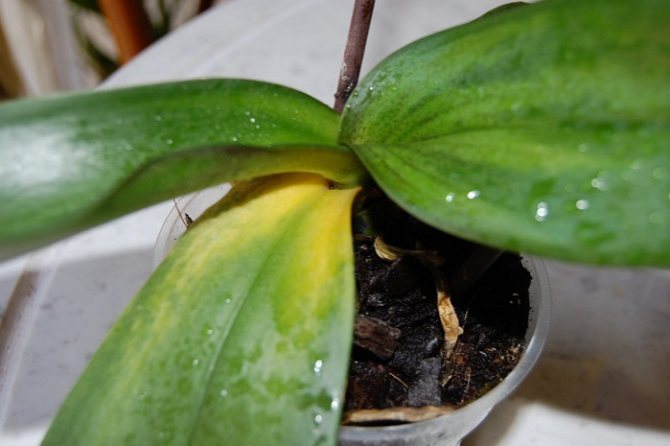

Chronic dampness and poor aeration of the substrate often cause the phalaenopsis to completely lose roots and then leaves. It is very difficult to treat phalaenopsis, the leaves of which began to ache due to waterlogging. Here you need to start with the cause and restore the root system. Treatment tactics will be as follows:
- Remove the orchid from the pot, free it from the damp substrate and cut off all rotten roots to living tissue;
- If the neck is damaged and the leaves turn yellow, remove the damaged leaves from the trunk, clean up the rotten places on the neck.
- Sprinkle all the cuts with crushed charcoal or ground cinnamon, put the phalaenopsis on a clean napkin and air dry for 24 hours.
- Prepare and disinfect the pot in the side holes, clean pine bark substrate without moss and other moisture-consuming components.
- Plant the orchid in a dry substrate, put the pot on wet expanded clay, put a bag on the remaining leaves and stand for up to 5 days.
- After 5 days, begin to water carefully, achieving quick and complete drying of the substrate.
After the phalaenopsis begins to grow new roots, the bag can be removed from the leaves.
Another leaf disease associated with improper irrigation is edema. It appears when a sheet plate, for some reason, is in prolonged contact with water at a low air temperature. For example, if you spray an orchid in the evening and leave it in a cool room overnight, pinpoint edema will appear on the leaves in the form of darkened areas.
Tip # 1. To avoid the appearance of edema on the leaves, Phalaenopsis need to arrange "water procedures" at a high air temperature. It is advisable to do this in the morning so that the plant has time to dry out by night.
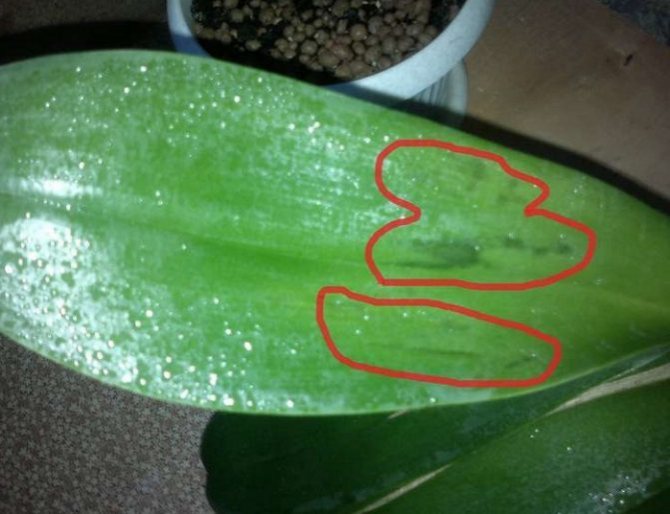

Traces of edema will no longer disappear from the leaves - this is a physiological disruption of the cells. If the damaged areas grow and soften, this will be a sign of infection.
Basic rules for growing orchids
Orchids will be healthy and blooming if you follow the rules for caring for them, which consist in observing the following factors:
- Temperature... In summer, the temperature for growing phalaenopsis should vary between + 25 ... + 28 ° С, and in winter it should not be lower than + 15 ... + 18 ° С.


- Lighting... Orchids require quite a lot of sunlight, but it should be diffused - the flower pot is best placed on an oriental windowsill. If it sits elsewhere, make sure the flowers and leaves of the orchid are the correct color. In warmer months, the pot can be taken out to the balcony or terrace, taking care that the plant is not exposed to direct sunlight, which these sensitive flowers are afraid of.
Did you know? Orchids form numerous and very small seeds that can only germinate in symbiosis with fungi. Due to their size, the seeds lack nutrient tissue and therefore can only germinate if they are infected with a fungus. - Moisturizing... These orchids do not tolerate wet soil - you need to water the flowers only when all the soil in the pot is dry. This can be checked by the weight of the pot: a pot of dry soil will be light, clicking on it will ring out. A container with wet soil will weigh significantly more. Depending on indoor conditions, the potted soil can dry out within 10-12 days.
In case of excessive watering, the root system of the plant is threatened with rotting. The water should not be too cold - its most optimal temperature will be room temperature. When the orchids fall into a dormant period, watering is significantly reduced (to two to three minimum waterings per month).

- Humidity... For the normal well-being of flowers in a residential building, air humidity should be maintained within 40-50%.
- Watering time... Orchids are watered in the morning: the soil substrate will dry out until the evening, which will prevent the occurrence of diseases associated with the effect of low temperatures on the wet parts of the flower. After abundant watering, you need to pour out the water that will drain from the pot into the pan. The best water for watering tropical beauties is distilled water, but you can also use boiled or settled tap water. In areas where there is no industrial pollution, the orchid can be dampened with rainwater, which it will love very much.
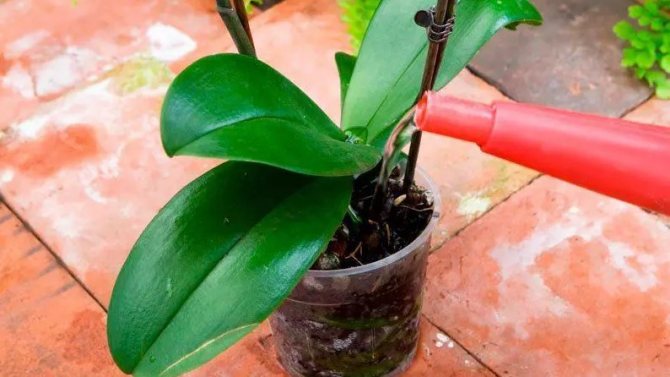

- Fertilizer... These plants do not need frequent feeding, one, maximum two feeding per month is enough, preferably with a special fertilizer for orchids.
- Substrate... A mixture of tree bark, coconut fiber, pine nut husks and perlite is used as a soil for growing orchids. This soil turns out to be permeable to moisture and air. There should be drainage at the bottom of the planting tank to prevent the roots from rotting.
Non-infectious leaf diseases associated with thermal disorders
Diseases from this subgroup develop most often through oversight. The success of their treatment largely depends on the severity of the lesion:
| Disease | Causes and symptoms | Treatment |
| Thermal burn | It develops with improper organization of artificial supplementary lighting: low position of lamps, use of DNaT lamps in orchidarium boxes. It is expressed in the appearance of dark dry spots or stripes on the epidermis of the leaf. | No special treatment is required. We need constant monitoring of the condition of damaged leaves and correction of additional lighting. After dying off, the diseased leaf is cut off. |
| Sunburn | It develops with prolonged exposure of Phalaenopsis in direct sunlight. It is expressed as dry spots of light or brown color with a yellow edge. In severe cases, there is dehydration and loss of turgor in all leaves. | In mild cases, no special treatment is required. Phalaenopsis is removed from direct sun and sprayed with water. In case of severe lesions with loss of turgor, the plant is moistened by dipping the pot and sprayed with Epin-Extra. |
| Frostbite | It develops in autumn or winter, when the phalaenopsis is left in front of an open window during airing. Expressed in the form of deep wrinkles, bumps and spots on the leaves. The plant is depressed, the leaves lose their turgor. | Damaged leaves are not regenerated. It is required to trim the frost-bitten areas to a green fabric with a cut with greenery. Phalaenopsis is rearranged in a warm place, is not watered for up to 10 days, and is not fed. Then normal care resumes. |
For thermal and sunburns, it is important to assess the extent of the damage. If the foci are small, there is no need to rush to cut the leaf - it will still serve the orchid. But sick leaves should be monitored constantly. If the burns begin to get wet, and the yellowness around them grows rapidly, you will have to trim the plate to healthy tissue.
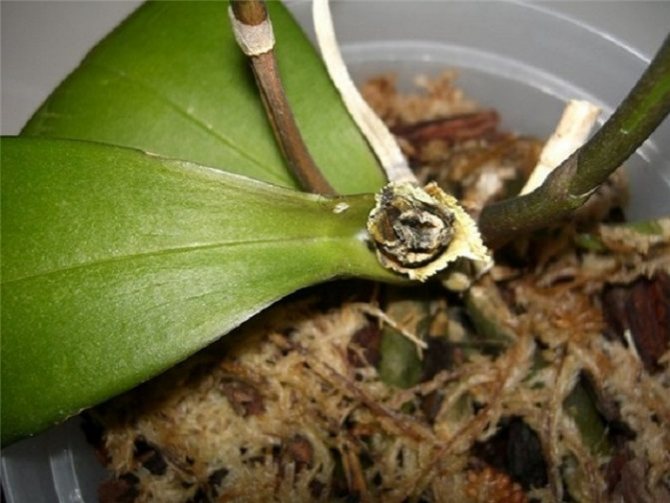

If, as a result of burns or frostbite, not only the leaf plates, but also the growth point are damaged, it must be removed. With good care, such a phalaenopsis can only recover from a root baby.
Non-communicable diseases


Often in orchids, improper agricultural practices become the cause of the disease. Flowers grow poorly and get sick from improper lighting, dry air, sudden changes in temperature, the use of aggressive drugs, and for other reasons. As a result, various spots appear on the plant, the shoots dry out, the root system dies.
Often, depressed dark or light spots appear on the surface of the leaf plates. The reason for their formation is a decrease in the temperature in the room by more than 4 degrees. The same effect appears when the flower is sprayed with cold water.
Important!
Chlorosis becomes the reason for the appearance of light areas on the leaves. It develops in orchids due to iron deficiency. For its assimilation, the plant needs an acidic environment. Excess fluoride fertilizers and hard water for irrigation make it impossible to assimilate this element.
Colorless wet patches on orchid foliage appear after short-term exposure of the orchid at temperatures below 0 degrees. Such areas are simply removed if they have not affected the stem or rhizomes. Sometimes stains appear after exposure to concentrated chemicals.
White sticky coating on leaves and stem
If a cobweb-like white sticky coating has formed on the leaves or stem, this is a sure sign of the presence of a mealybug... Under it, the pest lays its eggs. An adult female of white, beige or pink color reaches a length of no more than 5 mm, and the bristles along the body are strewn with a white powdery coating.
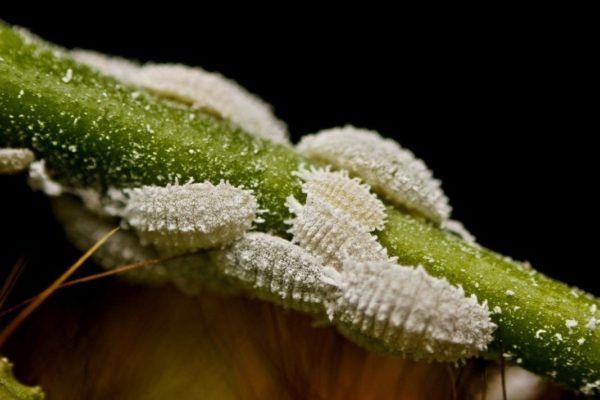

A white bloom on an orchid indicates the appearance of a mealybug.
Orchid defeat by mealybug occurs in several stages:
- The appearance of sticky drops on the leaf blade;
- Formation of a white, sticky coating, similar to cotton wool;
- Changing the shape of leaves and buds, the leaf blade acquires a marbled color with yellow or red spots.
In the later stages of the disease in the leaves the process of photosynthesis is disrupted, which leads to the death of the orchid.
Phalaenopsis leaf fungal infections and their treatment
The most common group of infections in orchids is fungal. Phalaenopsis can be affected by a large number of fungi, most of which settle on the leaves. Treatment of fungal infections is carried out using fungicidal drugs:
| Disease | Symptoms | Drugs for treatment |
| Fusarium | Softening and deformation of the sheet, the development of weeping spots and pinkish bloom. | "Fundazol": dilute 1 teaspoon of the drug in 2 liters of water, process the leaves and dry the orchid. Shown three times treatment with an interval of 10 days. |
| Gray rot | Soft moist spots on the leaves, covered with a fluffy gray coating. | "Topsin-M": dilute 1 g of the drug in 1 liter of water, process the leaves and dry the orchid. Re-processing - after 10 days. |
| Anthracnose | Small depressed black dots on the leaves, which gradually grow and merge into large spots. | "Oxyhom": dilute 2 g of the drug in 1 liter of water, process the leaves. Shown 3-5 times processing with an interval of 10 days. |
| Black rot (pytium) | The roots die off, the trunk wrinkles, hardens, the leaves turn black, softened, and when pressed, they release a mucous liquid. | It is very difficult to treat! All rotten tissues on the leaves are cut out and treated with Consento (4 ml per 1 liter of water). Treatment with roots, four times, with an interval of 10 days. |
| Phylostictosis | Small oval or diamond-shaped yellowish spots on the leaves, in the center of which black dots develop - foci of sporulation. | "Oxyhom": dilute 2 g of the drug in 1 liter of water, process the leaves. Shown 3-5 times processing with an interval of 10 days. |
If phalaenopsis has a fungal infection, it is necessary to temporarily stop watering and spraying. You also need to normalize the air temperature and light intensity.
In the initial stages of diseases, instead of chemical fungicides, you can try biological ones:
“I am allergic and I don’t use any chemicals in my house. I treat my orchids against fungi only with Fitosporin-M. If you catch a sore at the very beginning and do not waste time, "Fitosporin" helps very well "(Svetlana, Moscow).
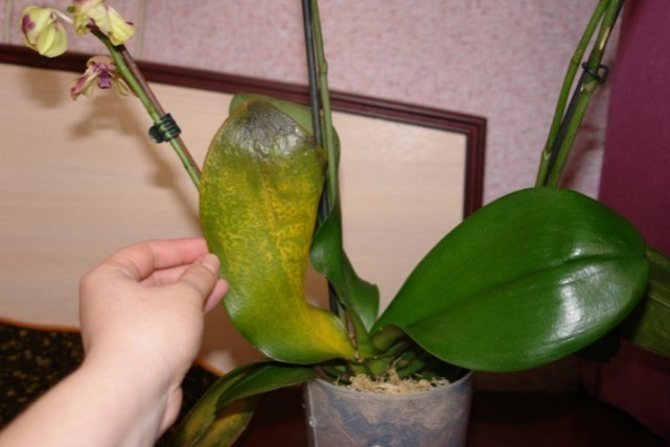

Fungal infections are more likely to affect phalaenopsis, for which improper care is carried out. Therefore, the complex of treatment should include not only the treatment with fungicides, but also the correction of the conditions of detention.
Treatment during care procedures and prevention
It may be interesting Dracula Orchid: description and care features; Caring for a chrysanthemum in a pot at home after purchase; Features of growing Chlorophytum at home
To prevent disease, orchids are regularly inspected. It is important to use only clean, disinfected tools and keep the pots clean. Before transplanting orchids, the substrate must be steamed. All weeds are removed regularly. Orchids are periodically sprayed with fungicide solutions to prevent infections and rot. During watering, try to prevent water from getting on the leaves. If this happens, remove the moisture with a napkin.
When replanting an orchid, after each incision, the instrument is disinfected. All plant residues are immediately removed after work. Before bringing a new plant into the apartment, it is carefully examined. Any damage, deformation or unusual shade of the leaves may indicate a latent disease that will soon manifest itself.
If in doubt, the plant is temporarily isolated and monitored. Periodically, this place is treated with disinfectants to prevent the spread of the disease.
The most effective preventive measure is to steam the soil before use. This procedure kills all pests and pathogens of infectious diseases. Orchids are very sensitive to pesticide exposure. Therefore, before using any drug, it must be checked. Spraying is carried out in the morning or in the evening, so that there is no active sun and high temperature.


Phalaenopsis leaf bacterial infections
Bacterial infections are caused not by fungi, but by bacteria, so fungicides are not used to treat them. To rid phalaenopsis of a bacterial disease, antibiotics are needed.
The most common infections in this group are caused by pseudomonas and ervinia:
- Soft bacterial rot (Taiwanese spots). Observed on phalaenopsis brought from Asia. It manifests itself in the form of extensive watery spots, which are surrounded by yellowness. Lesions in phalaenopsis grow very quickly, and the plant can die in just a few days. For treatment, tetracycline ointment or streptocide powder is used. Diseased leaves are completely removed, the sections are treated with antibiotics. The orchid dries out within 10-14 days.
- Bacterial spotting. It manifests itself in the form of bubbles on the epidermis of the leaves, which quickly turn into dark depressed spots that ooze mucous fluid. The diseased leaves are cut out, the sections are treated with streptocide powder or a crushed tablet of Trichopolum. The orchid is placed in cooler conditions and dried for 14 days.
It is extremely important to be able to distinguish between bacterial and fungal infections. One of the main distinguishing features is an unpleasant odor from discharge from lesions.


Any wet spots, regardless of location and size, can be a sign of a bacterial infection and require emergency intervention.
What to do?
Insect infestation
Sticky leaves are the result of infestation of indoor orchids by harmful insects, in particular: aphids, scale insects, whiteflies, ticks, worms. Insects are located on the back of the leaf and feed on the sap of the plant. The flower begins to dry, the leaves curl, sticky spots appear. If pests are detected with an unarmed eye, it is important to eliminate them as soon as possible.
Help:


Isolate infected orchid.- Remove insects with a cotton swab.
- Trim the affected areas if necessary.
- Wash the leaves with warm soapy water.
- Treat the plant with an intoxicide solution.
- Reduce watering during the cold season.
- Optimum temperature and humidity.
- You can temporarily hang up sticky tape for flies.
Diseases and their treatment
Infectious diseases are troubles that are quickly carried over. The cause for excitement is the presence of signs of powdery mildew disease. Harbingers: sticky layer on foliage, white bloom, it actively spreads. Over time, the plaque becomes black, the decay process develops.
Advice! Fighting this disease is not easy, it is recommended to take emergency measures.
If the orchid is sick, then it should:
Orchid pests
The list of the most common pests for phalaenopsis includes:
- aphid;
- mites of various types;
- mealybugs;
- earthworms;
- thrips;
- ants and spiders;
- wood lice and snails;
- whitefly;
- podura and nematodes;
- centipedes.
Some of these pests are sucking insects (spider mites, aphids) and feed on plant sap by sucking it out of the leaves. Snails and caterpillars are classified as pests that gnaw on plant tissue.
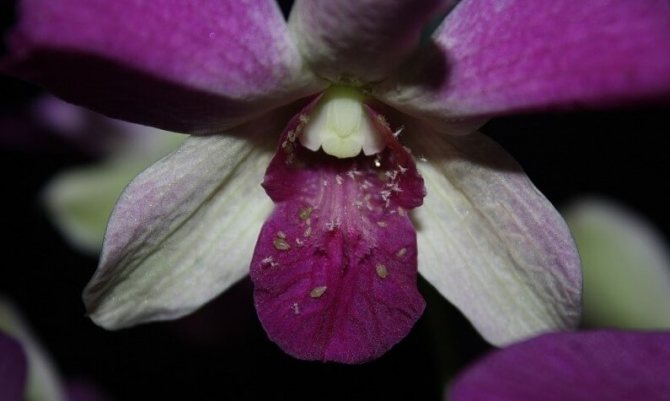

In order to correctly identify the pest, the grower needs to catch one specimen on the flower and compare its appearance with photographs on the Internet.
Did you know? No plant family has a wider range of shapes and colors than the Orchid family. Flowers can range in size from a few millimeters to over 20 centimeters in diameter. There are petals of any color: white, blue, green, red and yellow. Depending on the species, a plant can have more than a hundred flowers in one peduncle. The color of the leaves can be in all shades of green, red, brown and white.
Aphid
Aphids multiply very quickly, therefore, in a short time, insects can lead to a halt in the growth of phalaenopsis, the appearance of ugly stems or flowers, and discoloration of tissues. These are vectors of viral diseases, and honeydew secreted by flowers is a breeding ground for fungal spores. Aphids appear primarily on young shoots, leaves and flower buds.
Aphids are very small insects up to 3 mm long, usually green in color. The grower should quickly take action to prevent the colony from growing and becoming a threat to other indoor plants.
Tiny insects prefer high temperatures and dry indoor air. Aphids can migrate to orchids through an open window or newly acquired flowers that have not been quarantined.
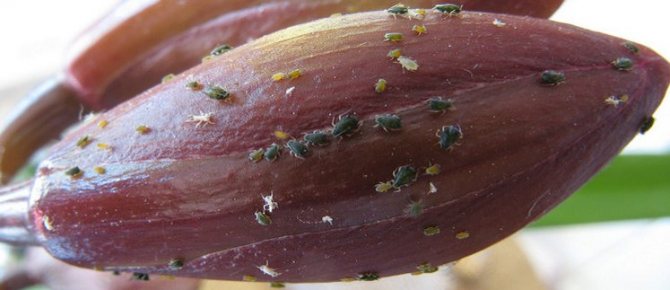

Small insects can be seen with the naked eye, therefore, the fight against a small colony can be carried out manually: wash them off with a stream of water or treat the plant with an insecticide.
There is also a species of aphid that lives in the underground part of the stem and in the roots. Their presence can be identified by the wrinkled leaves of the phalaenopsis.
It is worth noting that aphids are only a serious threat in large numbers. In the case of a systematic inspection of plants, the pest is easy to deal with. After the first application of any insecticide ("Aktellik", "Aktara"), it is necessary to repeat the procedure again with an interval of 10 days in order to destroy the next generations.
Did you know? Studies conducted by scientists at Harvard University in 2006 prove that orchids have been growing on our planet since the era of the dinosaurs. The results of a DNA test of one of the oldest fossils, preserved from the Miocene period, showed that plants already existed in the Cretaceous period.
—
the age of this species reaches 80 million years.
Spider mite
Spider mites are a very common problem when growing any potted plant. The colonization of phalaenopsis with ticks leads to significant damage and depression of the infected flower. Inhabiting the bottom of the leaf, spider mites suck sap from the leaf plate, as a result of which mosaic, yellow spots and a thin, weightless cobweb on their underside can be observed on the upper part of the leaves. Over time, the leaves become completely yellowed and wilted.
Spider mites are small greenish and red insects that usually do not exceed one millimeter in length. They are hard to see, so growers learn about their presence only when the first damage appears on the orchid. Spider mites pose a threat to flowers in their adult form and larval phase.
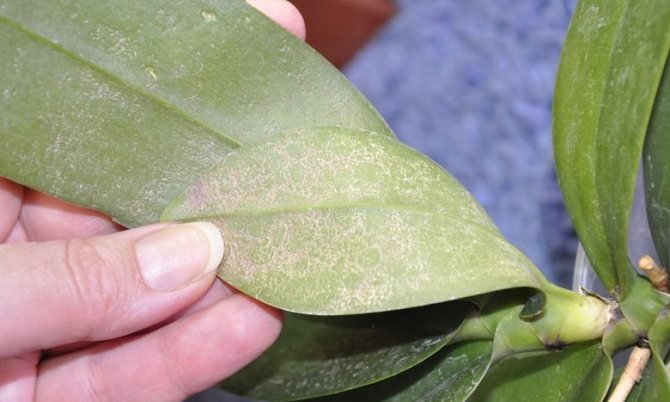

Pests infest plants that are in a room where the temperature is too high, dry air and low humidity. Also, spider mites like to settle on houseplants weakened by diseases.
The fight against spider mites, first of all, consists in quarantining an infected flower and thoroughly washing the leaves (under the shower or with a stream of water). This is followed by an immediate increase in humidity and a decrease in temperature in the room where the sick orchid is located. You can also do this: the flower needs to be well watered, and then put on a large plastic bag, which will fit the whole plant and the pot, and then leave in this position for 24 hours.Low humidity and fumes under the polyethylene will help eliminate pests.
In case of mass colonization of spider mites, insecticides can be used (Fitoverm, Aktellik, Neoron, Apollo, Tiofos). Repeated treatment of orchids with an insecticide is carried out after 10 days.
We recommend that you learn how to care for the cymbidium orchid at home.
Whiteflies
The whitefly looks like a small whitish moth, the body length of the insect is from 1 to 1.5 mm. Pests feed on the sap of leaves, buds and young flower shoots. As a result of their activity, small "marble" spots appear on the stems. Both adult whiteflies and their larvae harm plants, causing yellowness and drying of the leaves. Whitefly larvae can be deposited anywhere in the orchid: on the upper and lower plate of the leaf, in the roots.
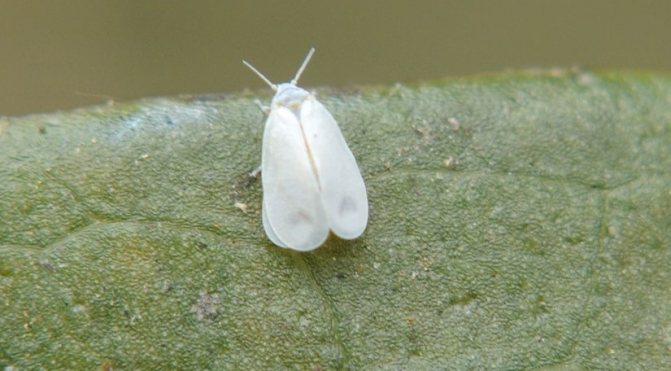

Plants attacked by whiteflies can be gently wiped with a soft sponge with soapy soap, and after a few hours apply (by spraying) the preparation Fitoverm to the flower and the soil in the pot. Spraying with Fitoverm should be repeated after seven days.
Did you know? The vanilla pods are the seed plants of the orchid, and more specifically, vanilla belongs to the varieties of vines belonging to the Orchid family.
Mealybug
These pests feed on the pulp of the leaves, which leads to inhibition of orchid growth, drying out and yellowing of the leaves. The insect prefers to dwell on the bottom of the leaf and in flower shoots.
The mealybug appears in June. Females with clutches of eggs or larvae hide under a convex sandy scaly shield located at the bottom of the leaf. Worms feed on plant juices, thereby causing damage to plants. Phalaenopsis, weakened by the mealybug, becomes susceptible to fungal diseases.
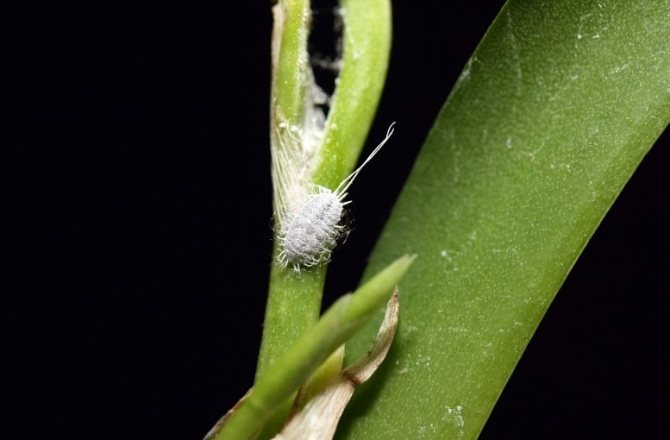

These insects love warm and dry climates; they usually end up in an apartment with newly brought plants. In addition to phalaenopsis, the pest affects indoor plants such as oleanders or palms. The fight against mealybugs using chemicals is very difficult, because the insects take refuge under the shield they have built.
It is worth keeping an eye on the plants to prevent the pest from spreading too much. A small amount is easier to completely eliminate: a good way is to apply vegetable oil to the orchid leaves with a sponge. After a few days, you need to wash the oil from the leaves and remove the scaly shields with a brush along with the pests that have suffocated under them.
Video: how to save phalaenopsis from an invasion of pests
Phalaenopsis leaf viral infections
Of the viral infections, Phalaenopsis most often suffer from leaf mosaic. The disease is provoked by different strains and mutations of the orchid mosaic virus. It manifests itself in the form of chaotically located yellow spots with blurred edges, moving in dark green depressed spots.
Unfortunately, there are no cures for viral infections. And since they are contagious and can destroy the entire collection of orchids, diseased plants must be destroyed.
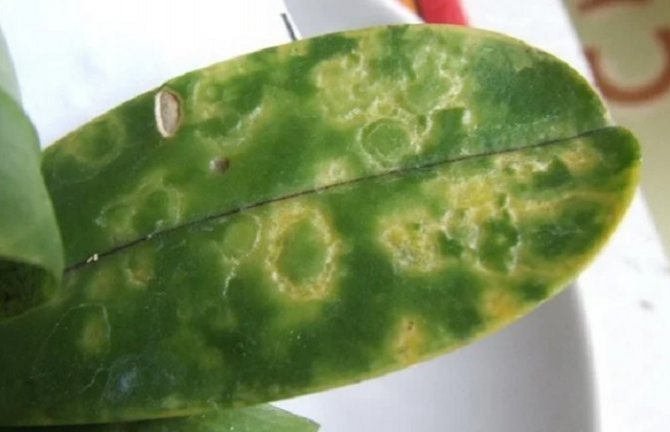

Viral infections are introduced to phalaenopsis, mainly by insect pests. Therefore, the timely destruction of aphids and other sucking parasites is the basis for the prevention of viral diseases.
Certain signs of viral infection of orchids
There are general symptoms that leave no doubt that the orchid is infected with a viral disease. First of all, this is the striped color of the petals - white, pinkish or dark strokes, or the presence of teeth or cuts on them against the background of weak growth and depressed state of the plant.
If young leaves appear with visible yellowish patterns: spots, strokes, various geometric shapes - rings, ovals, rhombuses, there is also every reason to assume that the orchid is infected with some kind of virus.Upon further observation, the pattern changes color - it turns black or becomes reddish-brown, and then dark brown and depressed.
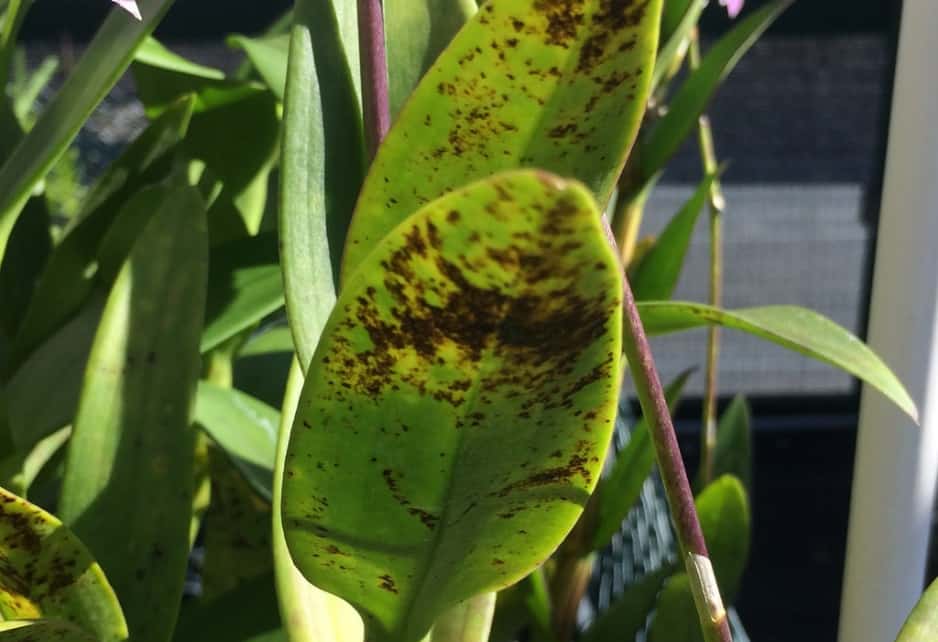

Rules for the prevention of leaf diseases of the phalaenopsis orchid
To prevent any diseases of the leaves of orchids of the genus Phalaenopsis, preventive measures must be observed:
- Maintain a strict two-week quarantine for new instances.
- Provide plants with ideal lighting conditions, normal temperature conditions and good aeration.
- Avoid waterlogging of the substrate.
- Do not spray or water orchids in low temperatures and poor light.
- Perform timely fertilizing with fertilizers containing potassium.
- Do not abuse growth and flowering stimulants.
It is also necessary to regulate the number of orchids in the collection. High crowding of plants in a small area with poor lighting and ventilation leads to outbreaks of epidemics.
General recommendations
Orchid problems are not always associated with infectious diseases. Most often these are common mistakes in care that lead to certain symptoms. This is where all problems begin, since weakened orchids are more susceptible to all sorts of infections.
Shade-loving indoor plants
So, make it a rule:
- grow orchids according to all the rules. If during the treatment you continue to ignore the optimal conditions of detention, then no treatment will help;
- when a new orchid appears in the house, quarantine it for 2 weeks or a month, since all diseases are infectious and quickly spread to nearby plants;
- keep diseased and "suspicious" orchids in as dry conditions as possible and never feed them!
Why does his leaves hurt?
An orchid is a capricious flower, so you need to take care of it carefully:
- water in a timely manner;
- monitor changes in temperature in the room in which he is located;
- provide him with enough light.
Orchid leaves are susceptible to all negative factors and quickly begin to hurt.
Even with proper care, viruses, infectious diseases, insect pests and aphids often cling to these tropical plants.
Reasons why orchid leaves can get sick:
- prolonged hypothermia;
- insufficient or excessive watering;
- lack of light;
- sunburn;
- overheating (steaming) of the plant;
- viral infection;
- insect pests.
Phalaenopsis preventive feeding expert advice
Potash dressing is one of the necessary measures for the prevention of orchid leaf diseases. But you need to be careful with fertilizing:
“Fertilizers cannot correct care mistakes. Do not think that the more we feed the orchids, the healthier they will be. Plants are more likely to get sick not because of underfeeding, but because of overfeeding. Especially not to abuse nitrogen fertilizers, which weaken the tissue of the leaves, make them loose, watery and permeable to any infections. "
A. Davydovskaya, owner of the greenhouse
Reasons for the appearance
The main cause of the problem is the weakened immunity of the plant itself, caused by mistakes in care or maintenance.
Too dry air in the room provokes the appearance of pests, and too humid - fungus. Cold and lack of lighting are dangerous. Overflow, stagnation of water in the substrate and the ingress of moisture into the axils of the leaves lead to the occurrence of putrefactive processes and favor the development of powdery mildew. Abuse of nitrogen fertilizers significantly impairs plant immunity. Infection can occur through the soil if it has not been disinfected prior to contact with the orchid. A fertile environment for the development of pathogenic microorganisms are fallen flowers and leaves withered from old age that are not removed from the pot in time.
The spores of the fungus can be carried by the wind and by insects that have flown into the house. Recently acquired flowers sometimes become a source of infection or parasites. To prevent them from infecting the rest of the collection, they should be quarantined initially.

